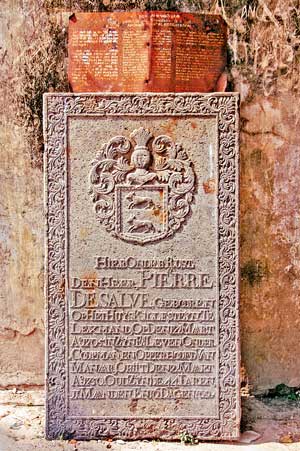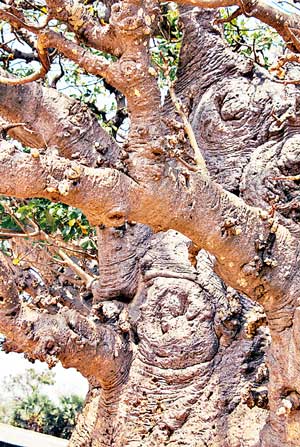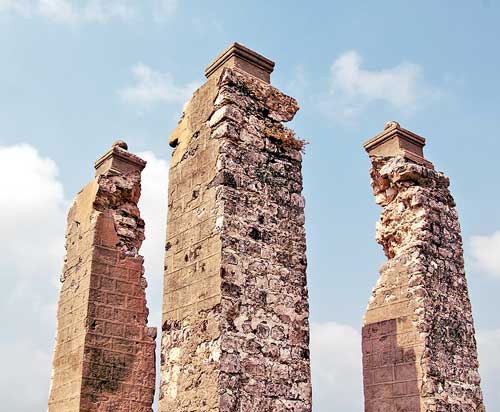Tuesday Dec 23, 2025
Tuesday Dec 23, 2025
Saturday, 3 June 2017 00:01 - - {{hitsCtrl.values.hits}}
By Aysha Maryam Cassim
Once a prosperous port city and a pearling centre, today Mannar looks forlorn and forgotten. Mannar Island has an area of about 50 square miles (130 square km). Talaimannar and Mannar are the two main towns located on the island.
The Mannar channel is about a mile in breadth, and separates the island of Mannar from Ceylon. Natives used to call this Odi-aroo or Seprent River. Years ago, it was navigable only for small country boats. At present, a 30-kilometre long causeway connects the Mannar Island to mainland Sri Lanka. The drive is breathtakingly beautiful.
Mannar is a mass of sea-sand covered land dotted with palmyrah trees and ancient African Baobabs. On the island, you’ll find remote fishing villages and wild donkeys wandering the streets in herds or solitude. Vankalai Sanctuary in Mannar District is a bird watcher’s paradise where you can witness the migratory Greater Flamingoes (Phoenicopterus Roseus) in flight.
Although Mannar hasn’t got lot to offer tourists, if you are heading up north, take a detour on your way back and make a stopover at Mannar to witness the windswept charm that is buried underneath this arid land.
Adam’s Bridge
Ceylon is separated from the South East extremity of the Indian peninsula by the Gulf of Mannar, which is crossed by a narrow ridge of rocks and sand formation, called Adam’s Bridge. The isle of Mannar lies at the eastern end of Adam’s Bridge, which runs about 30 miles in a northwest direction to the island of Rameswaram.
In Hindu mythology, this navigable passage between the two states is known as the Rama Setu, the place where Lord Rama with the help of the Vanara Sena or the army of apes, built a bridge across the sea to reach Lanka and defeat the demon King Ravana.

How did Mannar get its name?
The word Mannar is derived from the Tamil words “Man” (sand) and “Aar” (river). It is presumed that the inhabitants of Mannar started speaking the language of Malabars, the language what the people from the Coast of Coramandel spoke.
Philip Baladeus was a Missionary, who accompanied the Dutch forces, which took Jaffnapatam in 1658. He lived and worked there as for eight years till 1665. In his accurate and detailed description, complete with a map, Baladeus says that the island of Mannar was a part of Jaffnapatam. (Derived from the Sinhalese “Yapa Patuna”, Yapa – high-ranking official, Patuna – entrepot)
The prosperous port city
The Mahavansa mentions that Vijaya landed in Sri Lanka near Mahathitha (Manthota or Mannar), and named the island Thambapani (“copper-coloured sand”).
Once a prosperous port city in Ceylon, Manthai or Mahathitha was situated between mainland Ceylon and the island of Mannar. In the early centuries of the Christian era, Manthai was a prominent port city linking Ceylon to India and the Persian Gulf. The sea port was strategically located on the Ancient Silk Route from China to Europe. In Sangam literature we have references of the Tamils describing Mahathitta as a great port.
Historians believe that “Mahathitta” (Mathoddam) was also used as port by the Tamils long before the Aryan settlement in Ceylon. The existence of the Temple Tiruketheeswaram is an indication of the antiquity of the port.
“There are some ancient remains also at Mantota (called in Tamil Maka-tottal and a mala-tōtam) opposite the southern end of the island of Mannar, including those of a celebrated Tamil temple dedicated to Tirukesvaram, that is Vishnu; but this place is generally believed to be the Mahathittha of the historians, the “great landing place” for travellers from Southern India.” (Ancient Ceylon by Henry Parker.)

Pearl fishery in the Gulf of Mannar
Mannar coast was world famous for thousands of years for producing the finest pearls in the world. The lucrative pearl fishery in the Gulf of Mannar, which had been abandoned by the Dutch since the year 1768, was again carried out by the English in 1796. Pearls of Mannar were sold to the native princes and the finest of them were strung in necklaces and sent to Europe.
Oyster banks and coral reefs were scattered over a space of the Gulf. People who worked in the fishery gathered for a rendezvous in the Bay of Coondaatchy, South of Arippo. Merchants, fishermen and their diving crew set sailed from Mannar, Jaffna, Ramisseram and the Southern part of Coromandel Coast and anchored in Arippo. Arippo is a small village South of Mannar Island. It was believed that only good water of the coast could be found here.
Doric House at Arippo
Overlooking the shores of Mannar, the Doric House in Arippo stands isolated on a cliff in its antiquated splendour. Although much of its brick and mortar is in remnants today, it’s an important attraction in Mannar that you should not miss.
British Governor Sir Frederick North (1798-1805) built this bungalow as his official residence for the supervision of pearl fishery operations in the region. The Governor himself laid the foundation stone of the Doric building on 18 March 1802, and it took almost two years to complete the construction. “The building was later known as ‘The Doric’ due to the architectural design of the columns, which was similar to the Ancient Greek Doric order style.” (Wikipedia)

Pallimunai baobab tree
Two of the oldest baobab trees in Sri Lanka are found on the Delft Island and in Pallimunai, Mannar. It is presumed that Arab merchants planted this tree around 700 AD. The baobab tree at Pallimunai is the biggest known individual tree in Sri Lanka and has a girth of 62 feet.
Known as Ali Gaha (in Sinhala) and Peruku Maram in Tamil, these trees thrive in dry lands. They are usually tall and have enormous, swollen trunks, in which they store water during the dry season.
Mannar Fort
The fort in Mannar is a part of Ceylon’s proud maritime heritage. The Portuguese build this colonial military Fort in 1560 AD and then surrendered it to the Dutch and the British. It fell under the control of the Tamil Tigers during the country’s civil war and has been in a state of neglect and decay and subject to vandalism for many years.
The fort, which is situated next to the new bridge that connects the mainland with Mannar Island, can be visited by the public for free. The ancient bastions and ramparts have been invaded by vegetation. There is an old church inside, which has remains of an altar, baptismal pond and many old Dutch gravestones. If you walk over the ramp, you will be rewarded with a beautiful view of the ocean, causeway and Mannar town.